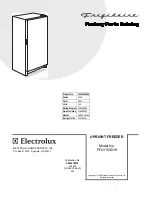
23
TROUBLESHOOTING
ENGLISH
Cooling system runs
too much.
The door is opened often or a large amount of food / hot food was added.
• Adding food and opening the door warms the freezer, requiring the compressor to run
longer in order to cool the freezer back down. In order to conserve energy, try to get
everything you need out of the freezer at once, keep food organized so it is easy to find,
and close the door as soon as the food is removed. (Refer to the Food Storage Guide.)
Doors are not closed completely.
• Firmly push the doors shut. If they will not shut all the way, the "Doors will not close
correctly or pop open" section in Troubleshooting.
Appliance is installed in a hot location.
• The compressor will run longer under warm conditions. At normal room temperatures (70
°F or 21 °C) expect your compressor to run about 40 % to 80 % of the time. Under warmer
conditions, expect it to run even more often. The appliance should not be operated above
110 °F (43 °C).
Condenser / back cover is clogged.
• Use a vacuum cleaner with an attachment to clean the condenser cover and vents. Do not
remove the panel covering the condenser coil area.
Interior moisture
buildup.
Doors are opened often or for long periods of time.
• When the doors are opened often or for long periods of time, warm, humid air enters the
compartment. This raises the temperature and moisture level within the compartment. To
lessen the effect, reduce the frequency and duration of door openings.
Doors are not closed correctly.
• See the "Doors will not close correctly or pop open" section.
Weather is humid.
• Humid weather allows additional moisture to enter the compartments when the doors are
opened leading to condensation or frost. Maintaining a reasonable level of humidity in the
home will help to control the amount of moisture that can enter the compartments.
Defrost cycle recently completed.
• During the defrost cycle, the temperature of each compartment may rise slightly and
condensation may form on the back wall. Wait 30 minutes and confirm that the proper
temperature has been restored once the defrost cycle has completed.
Food is not packaged correctly.
• Food stored uncovered or unwrapped, and damp containers can lead to moisture
accumulation within each compartment. Wipe all containers dry and store food in sealed
packaging to prevent condensation and frost.
Freezer section is too
cold.
Incorrect temperature control settings.
• If the temperature is too cold, adjust the control one increment at a time and wait for the
temperature to stabilize. Refer to the Control Panel for more information.
Frost or ice crystals
form on frozen food
(inside of sealed
package).
Condensation from food with a high water content has frozen inside of the food
package.
• This is normal for food items with a high water content.
Food has been left in the freezer for a long period of time.
• Do not store food items with high water content in the freezer for a long period of time.
Frost or ice crystals
form on frozen food
(outside of package).
Door is opened frequently or for long periods of time.
• When the doors are opened often or for long periods of time, warm, humid air enters the
compartment. This raises the temperature and moisture level within the compartment.
Increased moisture will lead to frost and condensation. To lessen the effect, reduce the
frequency and duration of door openings.
Door is not closing properly.
• Refer to the "Doors will not close correctly or pop open" section in the Troubleshooting.
Problem
Possible Cause & Solution














































